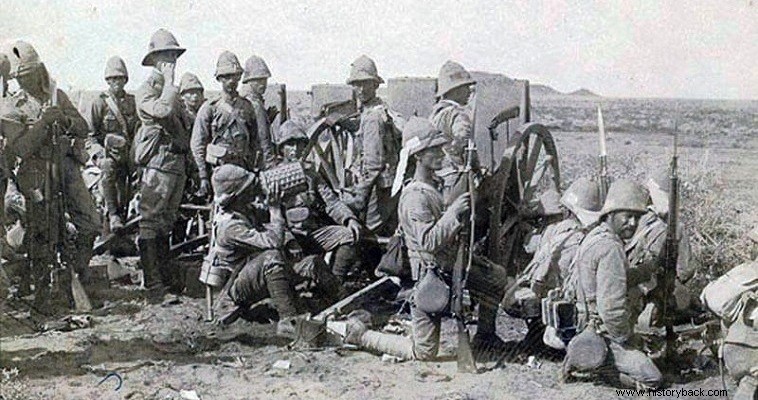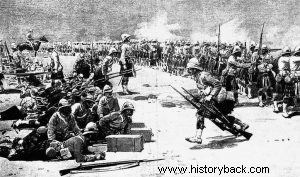
The British Lee Metford rifle, an ancestor of the Lee Enfield entered service in 1888. It was the first repeating rifle of the British Army and remained in use for many decades. It chambered a .303in (7.7mm) cartridge. The first Lee Enfield entered service in 1895.
When the repeating rifle was presented, the reactions against it were great. Previously the British Army used the 11.4mm Martini-Henry single-shot breech-loading rifle For various reasons "experts" and the press argued that the repeater was an expensive complex and bad rifle and that what the army needed was an improved Martini-Henry.
But the repeating rifle would soon prove its worth. In 1898, the British were still fighting hard in the Sudan against the then jihadists of the "Mahdi" movement (known as Dervishes). The decisive conflict took place in 1898 at Omdurman in the Sudan. There, under General Kitchener, a mixed army of 8,200 British and 17,600 Egyptian and Sudanese soldiers faced the jihadist forces' army of 52,000 men.
The British were equipped with the new repeating rifles. The Egyptians, the Sudanese, and some of their opponents carried Martini-Henry rifles. The difference was soon visible. The jihadists advanced against the British line. Dressed in white they kept coming closer. First the regiment of British Guards was ordered to open fire on them from a distance of 2,470 m. Seaforth's regiment followed when the opponents had reached 1,800 m. and then the rest of the regiments.
As the distance closed a Sudanese brigade opened fire. The British, professional soldiers, with characteristic composure, charged against the jihadists achieving incredible rates of fire with their repeating rifle. Lee Metfords achieved a rate of fire of 20 bpm. (shots per minute), while the Lee Enfield higher.
The rifles were "lighted up" and the soldiers of the first line were given more than the regiments of the second line. Bullets whistled through the air. "Each shot and on the other side the bullets pierced the flesh, crushed and shattered bones. Blood was flying from the terrifying wounds", says eyewitness Winston Churchill who fought there.
The fanatical jihadists did not stop, however, but launched a general attack. They reached a distance of 800m. by the British, but there they were halted by heavy fire, sustaining fearful losses. On the contrary, one of the Martini-Henry armed Sudanese managed to reach a distance of 300 m., 100 m. But a British regiment with repeaters deployed at an angle, flanking the Sudanese front.
The men were given the order to "fire at will". In two minutes it was all over. The jihadists had been crushed. At a cost of only 48 dead the British had inflicted almost 24,000 casualties on their opponents (9,700 dead, over 13,000 wounded). Of course not all jihadists were killed by the repeats. But many of them fell victim to them.
And just the fact that the British opened fire from 2,400+ m says a lot about the reliability of the weapon and of course their training.

Scottish regimental soldiers exchange "hot" rifles for cold ones...
